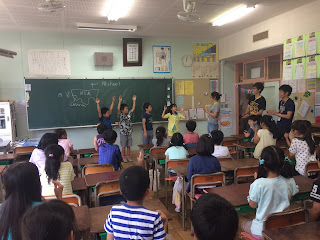Monday, June 22
I have to say, the first day of our cultural exchange with the students of Waseda University was phenomenal.
When we first arrived in Takadanobaba, we were greeted by Natsumi, a student who had visited the University of San Diego this past February. She, along with Shun, gave us a tour of the campus.
Waseda University's Library
Natsumi commented that Olive was the first to try to imitate the Founder's facial expression instead of taking a picture of his majestic frown.
Where classic meets modern inside this renovated building.
Paul, Micheal, and Olive enjoying a fresh cup of water in Waseda's cafeteria.
Can't visit a University without taking a group picture with Waseda's mascot.
After out tour around the campus, both USD and Waseda students gave a presentation of their action research.
Paul gave us a brief overview of his Action Research, addressing the issues students face when solving word problems.
Gwen shared with us her passionate belief that all children are capable of learning and that as educators we must analyze how we explain subjects to students.
Michael showed us the importance of educators listening to students' feedback to improve their practice and who they are as individuals.
Olive and Nicole shared their observations at USD's ELA and the various concerns that surrounds the assessment of students needs.
Natsumi's presentation was a perfect example of how to combine two paradigms and come to one's own understanding of reality.
Shun's presentation caused everyone to become conscious of the various stages of reflections we undergo as educators.
As a break between presentation, we had a wonderful lunch. I know it looks strange, but honestly, it actually quite delicious.
You can't end the day without having a bowl of noodles.














































